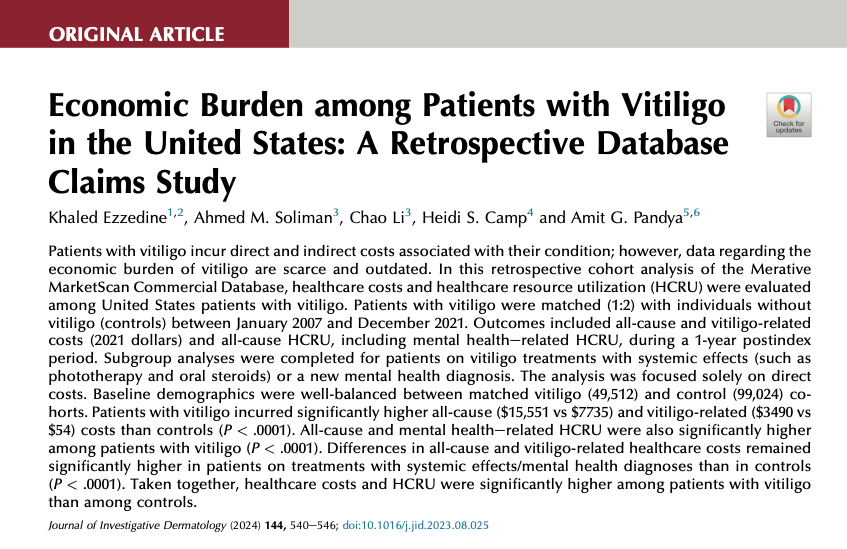New
Economic Burden Among Patients With Vitiligo in the United States
This study, conducted in the United States, evaluates the financial and healthcare resource utilization (HCRU) impact of vitiligo by comparing patients with the condition to those without it. Utilizing data from the Merative MarketScan Commercial Database between January 2007 and December 2021, it matched vitiligo patients with controls based on demographic factors. The findings reveal significantly higher healthcare costs and HCRU for vitiligo patients, underscoring the condition's substantial economic burden. The majority of patients are female (80%), with a median age of 43, predominantly from the South (30%), followed by the Midwest (22%).
Background
Patients with vitiligo face direct costs associated with their condition, including medical fees, pharmacy expenses, and out-of-pocket costs for items like sunscreens, protective clothing, and cosmetic products. Yet, data on vitiligo's economic burden are scarce and outdated. For instance, data from over 150,000 Americans treated for vitiligo in 2013 suggested an estimated cost to the healthcare system of more than $328 per patient, which is three times the cost associated with rosacea and double that for acne.
Key Findings
- In a match of 49,512 vitiligo patients with 99,024 controls, vitiligo patients incurred significantly higher costs: $15,551 versus $7,735 for all causes, and $3,490 versus $54 specifically for vitiligo-related care.
- Healthcare utilization, including visits to emergency rooms, inpatient admissions, and outpatient appointments, was notably higher among vitiligo patients.
- Subgroup analyses of patients receiving treatments with systemic effects or those with new mental health diagnoses revealed even higher costs and HCRU, highlighting an increased burden within these subgroups.
Discussion
The economic impact of vitiligo ($15,551) in the U.S. mirrors that of other dermatological conditions like atopic dermatitis ($14,603) and psoriasis ($11,062), with medical costs driving the increased expenses. Outpatient visits (an average $154), in particular, were a significant cost factor, aligning with the cost drivers identified in studies of other skin conditions. The higher costs observed for vitiligo patients may be partly due to a greater prevalence of mental health conditions and other comorbidities, such as thyroid disease, diabetes, and alopecia areata, which affect disease costs.
As anticipated, costs correlated with disease severity, especially evident in patients undergoing treatments with systemic effects or with new mental health diagnoses. The study also observed a higher prevalence of vitiligo among females (79%), possibly due to more proactive health-seeking behaviors regarding skin pigmentation changes.
This study focused exclusively on direct costs. Further research is needed to assess the full economic burden of vitiligo, including indirect medical costs like work productivity, early retirement, or lost opportunities. A parallel analysis found that vitiligo patients were more likely to have autoimmune or mental health comorbidities than matched controls, likely contributing to an increased economic burden and reduced quality of life (QOL). The results might not be applicable to populations outside of the United States.
Conclusion
This study underscores the significant economic burden imposed on U.S. patients with vitiligo, particularly those undergoing systemic treatments or dealing with mental health issues. The findings call for cost-effective treatments and a deeper understanding of the economic drivers behind vitiligo.
Published in Journal of Investigative Dermatology (vol. 144, pages 540-546, 2024) on September 20, 2023. DOI: https://doi.org/10.1016/j.jid.2023.08.025
Links to: Valle Y, Korobko I, Sigova J, et al. Patient-reported outcomes: a 5-year long study reveals previously unreported therapeutic, demographic, socio- economic, and other correlations in vitiligo. Dermatol Ther 2018;31: e12620.

FAQOther Questions
- Which diseases most commonly accompany vitiligo?
Vitiligo is an autoimmune disease and is frequently associated with other autoimmune diseases, acccording to a 10-year study. The exact diseases that accompany vitiligo can vary...
- Are there any famous people with vitiligo?
Many celebrities have dealt with vitiligo while remaining in the public eye, maintaining a positive outlook, and having a successful career. Here are a few courageous famous peo...
- Is vitiligo contagious?
Vitiligo is not contagious. This means it cannot be spread from person to person through physical contact, sharing personal items, or any other means of transmission. Vitiligo ...
Though it is not always easy to treat vitiligo, there is much to be gained by clearly understanding the diagnosis, the future implications, treatment options and their outcomes.
Many people deal with vitiligo while remaining in the public eye, maintaining a positive outlook, and having a successful career.
Copyright (C) Bodolóczki JúliaBy taking a little time to fill in the anonymous questionnaire, you can help researchers better understand and fight vitiligo.
